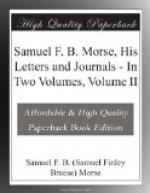“Thanks to you, my dear C——, for the concern you express in regard to my health. It has been perfectly good and is now, with the exception of a little anxiety in relation to the telegraph and to my great pictorial undertaking, which wears the furrows of my face a little deeper. My Telegraph, in all its essential points, is tested to my own satisfaction and that of the scientific gentlemen who have seen it; but the machinery (all which, from its peculiar character, I have been compelled to make myself) is imperfect, and before it can be perfected I have reason to fear that other nations will take the hint and rob me both of the credit and the profit. There are indications of this in the foreign journals lately received. I have a defender in the ‘Journal of Commerce’ (which I send you that you may know what is the progress of the matter), and doubtless other journals of our country will not allow foreign nations to take the credit of an invention of such vast importance as they assign to it, when they learn that it certainly belongs to America.
“There is not a thought in any one of the foreign journals relative to the Telegraph which I had not expressed nearly five years ago, on my passage from France, to scientific friends; and when it is considered how quick a hint flies from mind to mind and is soon past all tracing back to the original suggester of the hint, it is certainly by no means improbable that the excitement on the subject in England has its origin from my giving the details of the plan of my Telegraph to some of the Englishmen or other fellow-passengers on board the ship, or to some of the many I have since made acquainted with it during the five years past.”
In this he was mistaken, for the English telegraph of Cooke and Wheatstone was quite different in principle, using the deflection, by a current of electricity, of a delicately adjusted needle to point to the letters of the alphabet. While this was in use in England for a number of years, it was gradually superseded by the Morse telegraph which proved its decided superiority. It is also worthy of note that in this letter, and in all future letters and articles, he, with pardonable pride, uses a capital T in speaking of his Telegraph.
One of the most difficult of the problems which confront the historian who sincerely wishes to deal dispassionately with his subject is justly to apportion the credit which must be given to different workers in the same field of endeavor, and especially in that of invention; for every invention is but an improvement on something which has gone before. The sail-boat was an advance on the rude dugout propelled by paddles. The first clumsy steamboat seemed a marvel to those who had known no other propulsive power than that of the wind or the oar. The horse-drawn vehicle succeeded the litter and the palanquin, to be in turn followed by the locomotive; and so the telegraph, as a means of rapidly communicating intelligence between distant points, was the logical successor of the signal fire and the semaphore.




